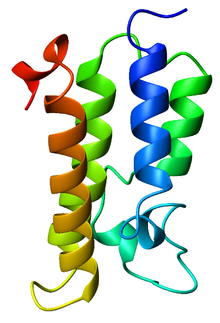
Back Bromodomini Catalan Bromodominio Spanish ブロモドメイン Japanese Бромодомен Macedonian Bromodomein Dutch Bromodomínio Portuguese Бромодомен Russian Bromodomen Serbo-Croatian Bromodomen Serbian 布罗莫结构域 Chinese
| Bromodomain | |||||||||||
|---|---|---|---|---|---|---|---|---|---|---|---|
 Ribbon diagram of the GCN5 bromodomain from Saccharomyces cerevisiae, colored from blue (N-terminus) to red (C-terminus).[1] | |||||||||||
| Identifiers | |||||||||||
| Symbol | Bromodomain | ||||||||||
| Pfam | PF00439 | ||||||||||
| InterPro | IPR001487 | ||||||||||
| SMART | SM00297 | ||||||||||
| PROSITE | PDOC00550 | ||||||||||
| SCOP2 | 1b91 / SCOPe / SUPFAM | ||||||||||
| CDD | cd04369 | ||||||||||
| |||||||||||
A bromodomain is an approximately 110 amino acid protein domain that recognizes acetylated lysine residues, such as those on the N-terminal tails of histones. Bromodomains, as the "readers" of lysine acetylation, are responsible in transducing the signal carried by acetylated lysine residues and translating it into various normal or abnormal phenotypes.[2] Their affinity is higher for regions where multiple acetylation sites exist in proximity. This recognition is often a prerequisite for protein-histone association and chromatin remodeling. The domain itself adopts an all-α protein fold, a bundle of four alpha helices each separated by loop regions of variable lengths that form a hydrophobic pocket that recognizes the acetyl lysine.[1][3]
- ^ a b PDB: 1e6i; Owen DJ, Ornaghi P, Yang JC, Lowe N, Evans PR, Ballario P, Neuhaus D, Filetici P, Travers AA (November 2000). "The structural basis for the recognition of acetylated histone H4 by the bromodomain of histone acetyltransferase gcn5p". EMBO J. 19 (22): 6141–9. doi:10.1093/emboj/19.22.6141. PMC 305837. PMID 11080160.
- ^ Ntranos, Achilles; Casaccia, Patrizia (2016). "Bromodomains: Translating the words of lysine acetylation into myelin injury and repair". Neuroscience Letters. 625: 4–10. doi:10.1016/j.neulet.2015.10.015. PMC 4841751. PMID 26472704.
- ^ Zeng L, Zhou MM (February 2002). "Bromodomain: an acetyl-lysine binding domain". FEBS Lett. 513 (1): 124–8. doi:10.1016/S0014-5793(01)03309-9. PMID 11911891. S2CID 29706103.